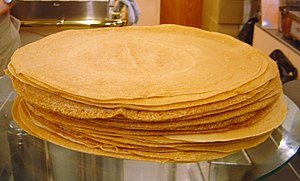Cookbook:Crêpe
Cookbook | Recipes | Ingredients | Equipment | Techniques | Cookbook Disambiguation Pages

A crêpe is a wide and thin pancake originating from France.
Technique
[edit | edit source]Batter
[edit | edit source]Crêpes should be very thin, so the batter for them must have certain characteristics. The batter should be thin and free of lumps in order to quickly and evenly coat the pan, but it needs to be strong enough to avoid tearing—the desired consistency is very similar to runny cream, and high-protein bread flour can contribute extra strength. Additionally, sieving the batter before use will eliminate any residual lumps. A bit of brandy or rum will add flavor to the batter, and a small amount of beer or sour milk will provide a subtle tang. Melted butter also adds flavor, but it can separate out of the batter if you choose to rest it overnight. If you do not want the batter to taste too "eggy", use fewer yolks than whites. If the batter is chilled overnight, it will thin slightly—be sure to account for this when preparing it. A basic ratio for the batter is 230 g eggs per 300 g flour, and then enough milk to make the correct consistency. Sugar and any other flavorings can then be added.
Cooking
[edit | edit source]Before you begin cooking, bring the batter to room temperature to avoid sticking. Choose a pan that you can lift and rotate easily so that you can quickly spread the batter around the pan. Ideally the pan should have sloping sides, and a non-stick coating is convenient. Even if you use a non-stick pan, be sure to brush the pan with a very thin coat of oil, which will help prevent sticking.
The pan should be heated over a fairly high heat before adding the batter. Once ready, add the minimum necessary batter to coat the bottom of the pan, and tilt to cover the entire base with a thin layer. The crêpe is ready to flip when the surface looks matte (i.e., no longer glistening with moisture). It usually takes 2–3 minutes for the first side to fully cook, followed by another fifteen seconds on the other side. Make sure to stir the remaining batter periodically while cooking to prevent the flour from sinking to the bottom of the bowl.
Instead of in a frying pan, crêpes can also be cooked on a specialized crêpe maker. These often afford better heat control and consistency, and the batter is spread using a special T-shaped wooden spreader. When cooking crêpes on one of these specialized plates, the batter can be slightly thicker since it is being manually spread out.
Troubleshooting
[edit | edit source]- Brittle crepes: add an egg to the batter.
Equipment
[edit | edit source]Crêpes can be made in a normal skillet, but specialized hot plates exist as well. The cheaper plates have a very thin coated surface. Because the plate has almost no mass, these versions are very lightweight; however, the heat is not very consistent at the surface. These plates are cheaper because the materials and heating elements are durable, and they are okay if you use them only rarely. Additionally, making crepe on a coated plate is not that easy as it slips around on the surface and the coating can get scraped off.
More expensive plates have a solid cast-iron plate and a progressive thermostat where you can set the exact temperature the plate should have. Because of the massive cast iron they are very heavy, a plate with a diameter of 40 cm weighs around 23 kg. These devices are more durable and can last a lifetime. Before using, they must be seasoned with fat to create a nonstick surface.
Only buy a plate that is even and has no lip at the edge, as a lip makes the turning of the crepe more difficult.
Use
[edit | edit source]Crêpes are often filled and/or topped with other ingredients, such as chocolate-hazelnut spread, sugar, lemon, fruits, ice cream, and more. When eaten with savory toppings/fillings, they are usually called galettes. Crêpes can also be layered with cream or frosting to make what is called a crêpe cake.
